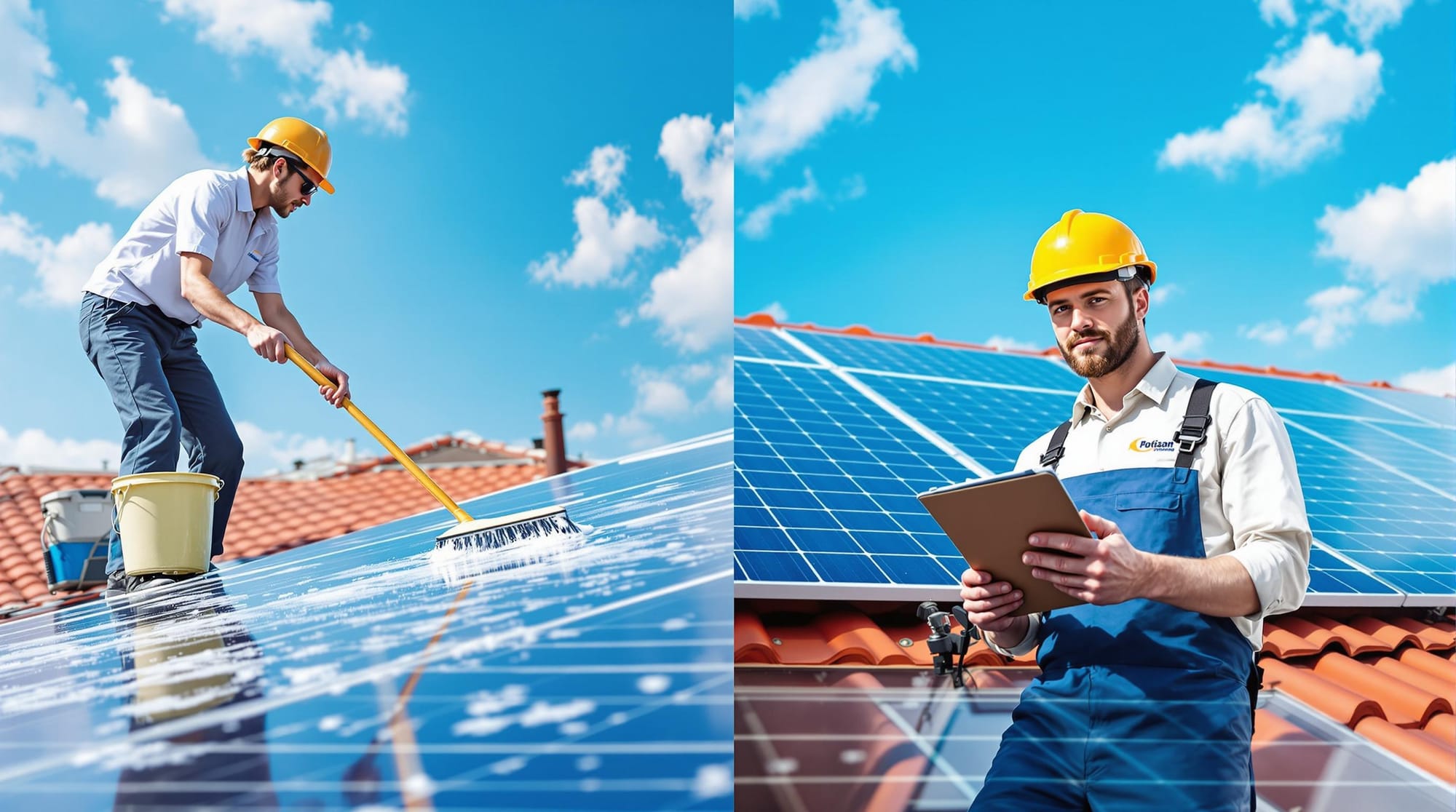DIY Solar Panel Cleaning vs. Professional Services
Explore the pros and cons of DIY solar panel cleaning versus hiring professionals to keep your system efficient and safe.

Should you clean your solar panels yourself or hire professionals? It depends on your setup, budget, and safety needs. Here's a quick breakdown:
- DIY Cleaning: Cheaper upfront, flexible timing, and great for small, easy-to-access systems. Costs around $50–$75 for tools but requires effort, safety precautions, and proper techniques to avoid damage or voiding warranties.
- Professional Services: Costlier ($150–$300 per session) but safer, more thorough, and includes inspections, warranty documentation, and advanced cleaning tools. Ideal for large, high, or hard-to-reach systems.
Quick Comparison
| Factor | DIY Cleaning | Professional Cleaning |
|---|---|---|
| Cost | $50–$75 for tools | $150–$300 per session |
| Safety | Risk of falls, damage | Professionals are insured |
| Time | 3–4 hours | 1–2 hours |
| Effectiveness | Moderate | Higher, with inspections |
| Warranty Protection | Risk of voiding warranty | Maintains warranty validity |
If your panels are easy to access and you’re comfortable with the process, DIY might work. For complex setups or added peace of mind, professional cleaning is worth the cost.
How to Clean Solar Panels THE RIGHT WAY
DIY Solar Panel Cleaning: Methods and Results
Cleaning your solar panels yourself can help keep them running efficiently, as long as you use the right tools and stay safe while doing it.
Why DIY Cleaning?
Doing it yourself can save you money. You’ll only need basic supplies costing around $50–$75, compared to spending $150–$300 for professional services. Plus, you can clean on your own schedule, like during cooler times of the day to avoid overheating the panels. Another perk? You get to inspect your panels up close and spot any issues right away.
What Are the Risks?
While DIY cleaning has its perks, there are some risks to consider:
- Falls: Working on steep roofs (over 18°) without proper safety gear can be dangerous.
- Panel Damage: Using the wrong tools or applying too much pressure can scratch or harm the panels.
- Warranty Problems: Some manufacturers void warranties if panels are damaged due to improper cleaning methods.
- Missed Spots: Without professional equipment, you might struggle to clean hard-to-reach areas or remove tough grime.
Staying Safe While Cleaning
Here are some safety tips to keep in mind:
- Gear Up: Use a nonabrasive brush, a 12–24-foot extension pole, non-slip shoes, a safety harness for pitched roofs, and biodegradable soap.
- Pick the Right Time: Clean on overcast mornings or when the panels are cooler (below 85°F). Avoid high winds, rain, or wet surfaces.
- Follow the Process: Rinse with deionized water, clean gently from top to bottom, and rinse thoroughly to remove soap residue.
DIY cleaning works best for single-story homes or roofs with a low slope. If your system is more complex or hard to access, professional cleaning might be a better option. Up next, we’ll dive into what professional services bring to the table.
Professional Solar Panel Cleaning: Services and Outcomes
Professional cleaning relies on specialized tools and expertise to keep your solar panels running efficiently. Here's a breakdown of what these services include and where they might fall short.
What Professional Services Offer
Experts in solar panel cleaning use advanced equipment, including:
- High-Grade Deionized Water Systems: Prevents mineral buildup on panels.
- Specialized Tools: Telescoping water-fed poles that can reach up to 40 feet.
- Safety Equipment: OSHA-approved gear for safe operation.
Their services go beyond cleaning and often include:
- System Inspection: Identifies microcracks, loose connections, or any visible damage.
- Performance Testing: Measures efficiency before and after cleaning.
- Documentation: Provides detailed reports with photos, which can support warranty claims.
- Bird Deterrent Installation: Optional add-ons like mesh or spike systems to keep birds away.
The cleaning process typically uses soft-brush techniques paired with deionized water to avoid static buildup and reduce dust attraction. For a standard residential system with 20–24 panels, the job usually takes 1–2 hours.
Limits of Professional Services
While professional services offer many benefits, there are some limitations to keep in mind:
| Limitation | Impact | Consideration |
|---|---|---|
| Cost | $150–$300 per service; multiple cleanings per year recommended | Minimum service charges apply. |
| Scheduling | 1–3 week wait times | Book ahead to avoid delays. |
| Weather Constraints | Cannot operate during rain or high winds | May require rescheduling. |
| Access Requirements | Clear access to panels is necessary | Ensure obstacles are removed beforehand. |
If you’re in a rural area, travel charges might be higher, and during peak seasons or emergencies, expect scheduling delays and potential rush fees (25–50% above regular rates). Planning ahead can help mitigate these challenges.
Cost and Results Comparison
Compare costs, time, and effectiveness to decide which cleaning method works best for you.
Here’s a side-by-side breakdown of key factors:
| Factor | DIY Cleaning | Professional Cleaning |
|---|---|---|
| Initial Investment | Requires buying a basic cleaning kit | No upfront equipment costs |
| Per-Clean Cost | Lower recurring supply costs | Fixed service fee |
| Time Investment | Takes several hours per session | Completed faster by experienced teams |
| Equipment Needed | Requires your own tools (e.g., pole, brush, solution) | All equipment is provided |
| Efficiency Impact | Improves panel performance noticeably | Often yields slightly better performance |
| Insurance Coverage | May not be covered by personal liability insurance | Professionals carry full coverage |
| Warranty Protection | Risk of voiding warranty with improper methods | Helps maintain warranty validity |
| Frequency | Often done more frequently by homeowners | Usually scheduled seasonally or bi-annually |
Additional Considerations
DIY Cleaning
- Involves significant physical effort.
- Requires learning proper techniques and safety precautions.
Professional Services
- Provide warranty documentation.
- Use advanced methods for tough stains.
- Offer emergency service options.
For a typical residential system, DIY cleaning means a higher upfront cost for tools but lower ongoing expenses. Professional services, on the other hand, come with higher recurring costs but include added perks like inspections and documentation.
If saving money and having control are your priorities, DIY might be the way to go. However, if you value convenience and added peace of mind, professional services could be the better choice. It all comes down to your budget, time, and how much assurance you’re looking for.
Making Your Choice: DIY or Professional
Best Times for DIY Cleaning
DIY cleaning works well when your solar panels are easy to access, and the conditions are safe. Consider going the DIY route if:
- The roof pitch is less than 30°
- Panels can be reached from the ground using extension tools
- You’re comfortable with basic maintenance and have good mobility
- Dirt buildup is light to moderate
- Weather is mild (50-75°F) with little to no wind
- You have 3-4 hours of daylight to spare
Safety Tip: Check your homeowner's insurance policy. Some plans may require professional work for anything above 10 feet.
When to Call Professionals
If your system doesn’t meet the DIY-friendly criteria, it’s time to bring in the pros. Here’s when professional cleaning is necessary:
Physical Challenges
- Roof pitch is steeper than 30°
- Panels are installed more than 15 feet off the ground
- Roofs are complex or have obstructions that make access difficult
Tough Cleaning Needs
- Heavy accumulations of bird droppings or tree sap
- Mineral deposits or tough stains that need special cleaning solutions
- Visible damage or loose components that require attention
Environmental Issues
- Areas with high pollution or frequent dust storms
- Nearby construction activity causing excessive dust
- Coastal regions where salt buildup is an issue
Documentation and Compliance
- Maintenance required to keep warranties valid
- Documentation needed for insurance claims
- Performance checks and detailed inspection reports for warranty or insurance purposes
Professionals also provide extra perks, such as:
- Performance checks to ensure your system is running efficiently
- Minor repairs and adjustments during cleaning
- Comprehensive inspection reports
- Maintenance records that align with warranty requirements
Pick the option that ensures your safety and keeps your panels working at their best.
Conclusion: Choosing Your Cleaning Method
Deciding how to clean your solar panels comes down to practicality and safety. The right approach depends on your setup and specific needs, but safety should always come first.
Here’s a quick breakdown of the options:
DIY cleaning works well when:
- You have the right safety gear and tools.
- Weather conditions are mild and predictable.
- You can stick to a regular cleaning schedule.
Professional cleaning is a better choice when:
- Specialized cleaning products are necessary.
- Warranty requirements call for professional documentation.
- A system inspection is needed alongside cleaning.
- Your installation is complex and requires expert care.
Many find that combining both methods works best - taking care of routine maintenance yourself and scheduling professional cleanings for deeper, more thorough care.
If you’re unsure where to start, consider hiring a professional first. They can show you the proper techniques and help you understand your system’s specific cleaning needs. Remember, your cleaning approach directly affects not just the efficiency of your panels but also their safety, ensuring they perform well for years to come.

